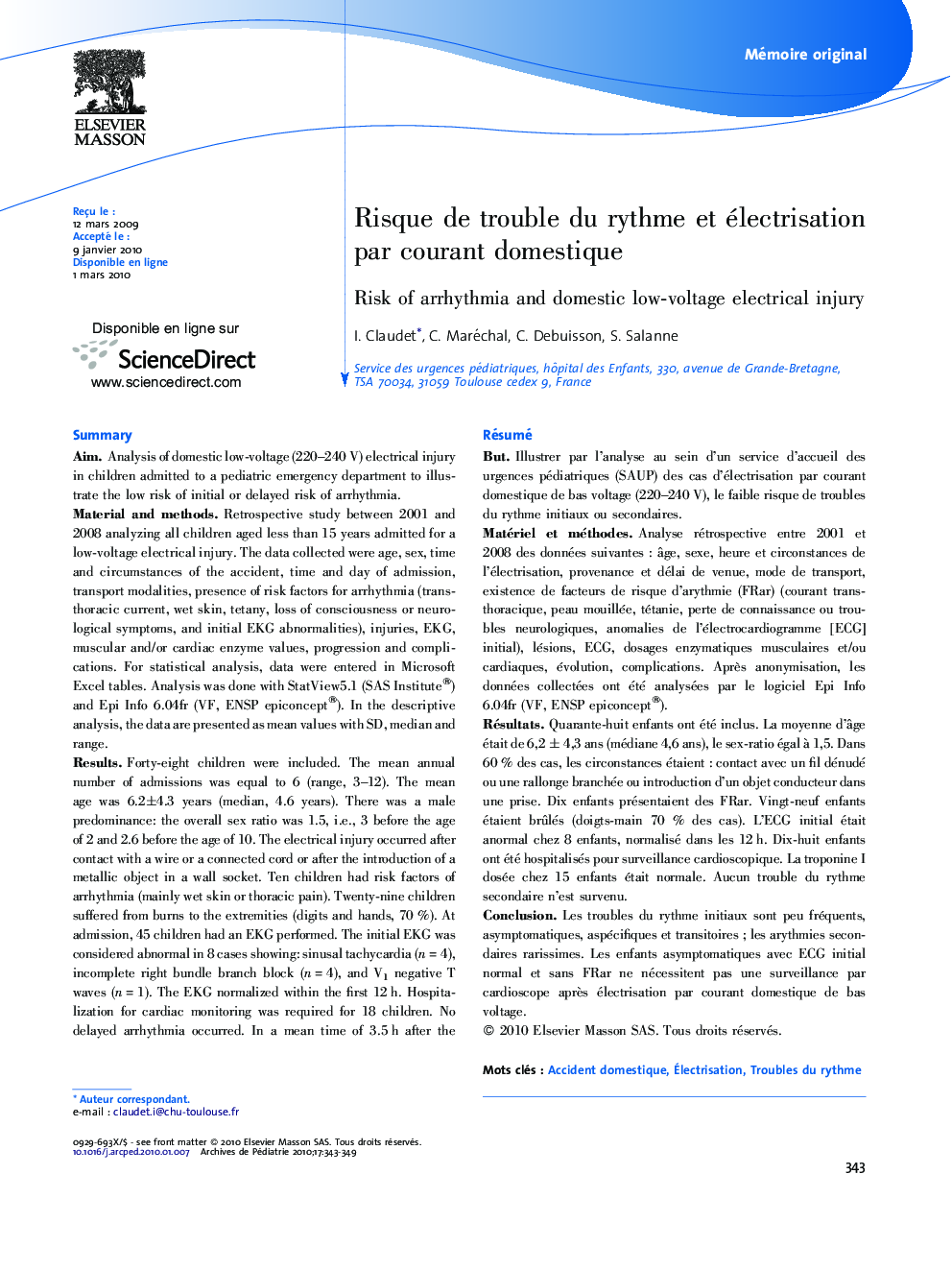| کد مقاله | کد نشریه | سال انتشار | مقاله انگلیسی | نسخه تمام متن |
|---|---|---|---|---|
| 4148946 | 1272718 | 2010 | 7 صفحه PDF | دانلود رایگان |

RésuméButIllustrer par l’analyse au sein d’un service d’accueil des urgences pédiatriques (SAUP) des cas d’électrisation par courant domestique de bas voltage (220–240 V), le faible risque de troubles du rythme initiaux ou secondaires.Matériel et méthodesAnalyse rétrospective entre 2001 et 2008 des données suivantes : âge, sexe, heure et circonstances de l’électrisation, provenance et délai de venue, mode de transport, existence de facteurs de risque d’arythmie (FRar) (courant transthoracique, peau mouillée, tétanie, perte de connaissance ou troubles neurologiques, anomalies de l’électrocardiogramme [ECG] initial), lésions, ECG, dosages enzymatiques musculaires et/ou cardiaques, évolution, complications. Après anonymisation, les données collectées ont été analysées par le logiciel Epi Info 6.04fr (VF, ENSP epiconcept®).RésultatsQuarante-huit enfants ont été inclus. La moyenne d’âge était de 6,2 ± 4,3 ans (médiane 4,6 ans), le sex-ratio égal à 1,5. Dans 60 % des cas, les circonstances étaient : contact avec un fil dénudé ou une rallonge branchée ou introduction d’un objet conducteur dans une prise. Dix enfants présentaient des FRar. Vingt-neuf enfants étaient brûlés (doigts-main 70 % des cas). L’ECG initial était anormal chez 8 enfants, normalisé dans les 12 h. Dix-huit enfants ont été hospitalisés pour surveillance cardioscopique. La troponine I dosée chez 15 enfants était normale. Aucun trouble du rythme secondaire n’est survenu.ConclusionLes troubles du rythme initiaux sont peu fréquents, asymptomatiques, aspécifiques et transitoires ; les arythmies secondaires rarissimes. Les enfants asymptomatiques avec ECG initial normal et sans FRar ne nécessitent pas une surveillance par cardioscope après électrisation par courant domestique de bas voltage.
SummaryAimAnalysis of domestic low-voltage (220–240 V) electrical injury in children admitted to a pediatric emergency department to illustrate the low risk of initial or delayed risk of arrhythmia.Material and methodsRetrospective study between 2001 and 2008 analyzing all children aged less than 15 years admitted for a low-voltage electrical injury. The data collected were age, sex, time and circumstances of the accident, time and day of admission, transport modalities, presence of risk factors for arrhythmia (transthoracic current, wet skin, tetany, loss of consciousness or neurological symptoms, and initial EKG abnormalities), injuries, EKG, muscular and/or cardiac enzyme values, progression and complications. For statistical analysis, data were entered in Microsoft Excel tables. Analysis was done with StatView5.1 (SAS Institute®) and Epi Info 6.04fr (VF, ENSP epiconcept®). In the descriptive analysis, the data are presented as mean values with SD, median and range.ResultsForty-eight children were included. The mean annual number of admissions was equal to 6 (range, 3–12). The mean age was 6.2±4.3 years (median, 4.6 years). There was a male predominance: the overall sex ratio was 1.5, i.e., 3 before the age of 2 and 2.6 before the age of 10. The electrical injury occurred after contact with a wire or a connected cord or after the introduction of a metallic object in a wall socket. Ten children had risk factors of arrhythmia (mainly wet skin or thoracic pain). Twenty-nine children suffered from burns to the extremities (digits and hands, 70 %). At admission, 45 children had an EKG performed. The initial EKG was considered abnormal in 8 cases showing: sinusal tachycardia (n = 4), incomplete right bundle branch block (n = 4), and V1 negative T waves (n = 1). The EKG normalized within the first 12 h. Hospitalization for cardiac monitoring was required for 18 children. No delayed arrhythmia occurred. In a mean time of 3.5 h after the accident, a troponin dosage was given to 15 children and was normal in all cases. One child developed rhabdomyolysis and evolved without needing dialysis.ConclusionAfter a low-voltage electrical injury, initial arrhythmia is not frequent, with often a nonspecific and transitory EKG expression; delayed arrhythmia is very rare. Children presenting to the emergency department after such an electrical accident, who are asymptomatic, without any risk factors for arrhythmia (wet skin, tetany, vertical pathway of the current, preexistent cardiological conditions, loss of consciousness) and with a normal initial EKG do not require cardiac monitoring.
Journal: Archives de Pédiatrie - Volume 17, Issue 4, April 2010, Pages 343–349